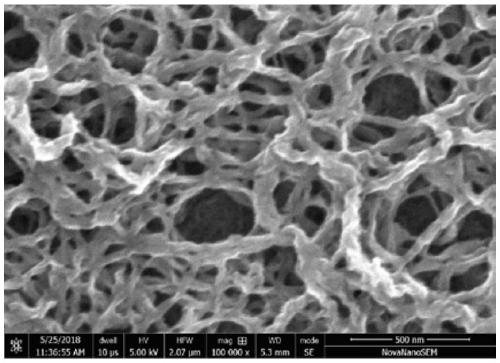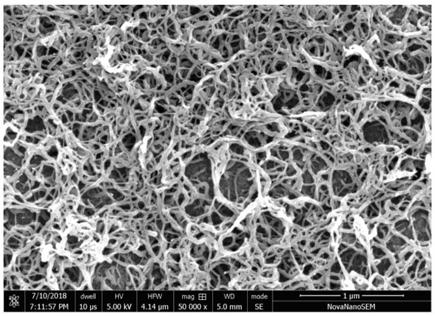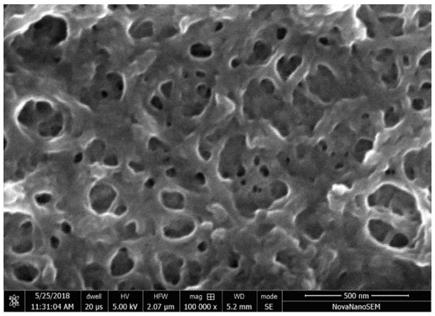Poly-3,4-ethylenedioxythiophene nano mesh structure film as well as preparation method and application thereof
A technology of ethylenedioxythiophene and network structure, applied in electrolysis process, electrolysis components, electrolysis organic production, etc., can solve problems such as the difficulty of nanostructured polymer materials, and achieve excellent electrochromic performance, environmental protection, and simple operation. Effect
- Summary
- Abstract
- Description
- Claims
- Application Information
AI Technical Summary
Problems solved by technology
Method used
Image
Examples
Embodiment 1
[0031] (1) In the three-electrode electrolytic cell system, EDOT (0.07109g, 0.5mmol) was used as a monomer, and LiClO 4 (1.0640g, 0.01mol) as the supporting electrolyte, with acetonitrile (100mL) as the electrolytic solvent, 100mL of a mixed solution with a monomer concentration of 5mmol / L and a supporting electrolyte concentration of 0.1mol / L was prepared as the electrolyte, and ITO conductive glass was used as the working Electrode, with platinum electrode as auxiliary electrode, silver / silver chloride electrode as reference electrode, saturated potassium chloride aqueous solution as the first liquid junction, and the electrolyte as the second liquid junction. At room temperature, the electrochemical polymerization reaction is carried out by cyclic voltammetry anodic oxidation polymerization. The blue polymer film on the electrode was rinsed with acetonitrile to remove the residual electrolyte on the surface of the polymer film and dried in a vacuum drying environment at 60°...
Embodiment 2
[0034] In the three-electrode electrolytic cell system, EDOT (0.07109g, 0.5mmol) was used as a monomer, and LiClO 4 (1.0640g, 0.01mol) as the supporting electrolyte, with acetonitrile (100mL) as the electrolytic solvent, 100mL of a mixed solution with a monomer concentration of 5mmol / L and a supporting electrolyte concentration of 0.1mol / L was prepared as the electrolyte, and ITO conductive glass was used as the working The electrode is a platinum electrode as an auxiliary electrode, a silver / silver chloride electrode as a reference electrode, a saturated potassium chloride aqueous solution as the first liquid junction, and the electrolyte as the second liquid junction. At room temperature, the electrochemical polymerization reaction was carried out by constant potential method 1.4V, the polymerization power was 0.05C, and then dedoped at negative potential -0.8V for 50s to obtain a layer of blue polymer film deposited on the ITO working electrode. The polymer film was obtaine...
Embodiment 3
[0036]In the three-electrode electrolytic cell system, EDOT (0.07109g, 0.5mmol) was used as a monomer, and LiClO 4 (1.0640g, 0.01mol) as the supporting electrolyte, with acetonitrile (100mL) as the electrolytic solvent, 100mL of a mixed solution with a monomer concentration of 5mmol / L and a supporting electrolyte concentration of 0.1mol / L was prepared as the electrolyte, and ITO conductive glass was used as the working Electrode, with platinum electrode as auxiliary electrode, silver / silver chloride electrode as reference electrode, saturated potassium chloride aqueous solution as the first liquid junction, and the electrolyte as the second liquid junction. Electrochemical polymerization was carried out at room temperature using the constant potential method 1.6V, the polymerization power was 0.05C, and then dedoped at a negative potential of -0.8V for 60s to obtain a layer of blue polymer film deposited on the ITO working electrode. The polymer film was obtained by rinsing wi...
PUM
| Property | Measurement | Unit |
|---|---|---|
| Coloring time | aaaaa | aaaaa |
Abstract
Description
Claims
Application Information
 Login to View More
Login to View More - R&D
- Intellectual Property
- Life Sciences
- Materials
- Tech Scout
- Unparalleled Data Quality
- Higher Quality Content
- 60% Fewer Hallucinations
Browse by: Latest US Patents, China's latest patents, Technical Efficacy Thesaurus, Application Domain, Technology Topic, Popular Technical Reports.
© 2025 PatSnap. All rights reserved.Legal|Privacy policy|Modern Slavery Act Transparency Statement|Sitemap|About US| Contact US: help@patsnap.com



